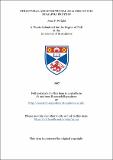Structural and functional analysis of the IkBalpha protein
Abstract
NF-KB/Rel transcription factors and IKB proteins play a central role in the rapid induction of genes transcribed in response to a variety of extracellular stimuli. Signal induction results in the phosphorylation and ubiquitination of IKBalpha a prior to proteasomal degradation and release of NF-KB. The objective of this work was to identify residues within the N- and C-termini of IKBalpha which were important for the function of the protein, specifically the residues contacting the p65 subunit of NF- KB and those involved in the turnover of IKBalpha. In addition, the structure of the C-terminal region of IKBalpha was also examined to gain a better understanding of the functional properties of this domain. The identification of conserved stretches of acidic residues in the C-terminal region of IKBalpha prompted the suggestion that perhaps these amino acids were important for interacting with the positively charged nuclear localisation signal of the p65 subunit of NF- KB. Accordingly two regions, residues 284-286 and residues 300-302 (glutamic acid, aspartic acid, glutamic acid in both regions), were targeted for mutation (and referred to as the C-terminal mutants) to examine their role, if any, in IKBalpha -p65 association. A second set of mutants were generated following a protease sensitivity study on IKBalpha which revealed that residues 251 (tyrosine), 258 (tryptophan) and 275 (glutamic acid) were protected from digestion in the presence of p65. These amino acids were located in the low homology sixth ankyrin repeat of IKBalpha, thought to act as a flexible linker region between the highly conserved central five ankyrin repeats and the C-terminal region of the protein. Consequently, amino acids 258 and 275 were selected for mutation (referred to as the linker mutants). The in vitro characterisation of the C-terminal and linker mutants demonstrated that neither amino acids 258 and 275 nor amino acids 284-286 and 300-302 affected the ability of IKBalpha to interact with p65 homodimers, even under conditions of varying pH or ionic strength. However, residues 284-286 reduced the inhibitory capacity of IKBalpha with respect to p65 homodimers. The results indicated that the region of IKBalpha required for the inhibition of p65 DNA binding activity, possibly located in or around residues 284-286, was separable from the area of the protein responsible for association with p65. Attempts to phosphorylate the C-terminal and linker mutants in vitro using either casein kinase I or casein kinase II demonstrated that the C-terminal mutants were not efficiently phosphorylated by casein kinase II but were phosphorylated by casein kinase I. Both kinases were shown to phosphorylate wild-type IKBalpha and the linker mutants. Therefore, residues 284-286 and 300-302 were possibly important for the in vivo phosphorylation of IKBalpha through casein kinase II. The expression of the C-terminal and linker mutants from vectors transiently transfected into 293 cells revealed that residues 284-286 and residues 300-302 were required for either inducible or constitutive degradation of IKBalpha, but more likely constitutive turnover. All mutants appeared to undergo signal-induced ubiquitination. Furthermore, the mutants were capable of interacting with p65 and in a different cell line (Cos7 cells) all appeared to allow NF-KB-dependent transcription from a luciferase reporter. The final result was thought to be a consequence of different degradation characteristics existing within Cos7 cells compared to 293 cells. In the light of recent data, it was concluded that the C-terminal residues of IKBalpha were important for constitutive, rather than inducible turnover of IKBalpha.
Type
Thesis, PhD Doctor of Philosophy
Collections
Items in the St Andrews Research Repository are protected by copyright, with all rights reserved, unless otherwise indicated.

